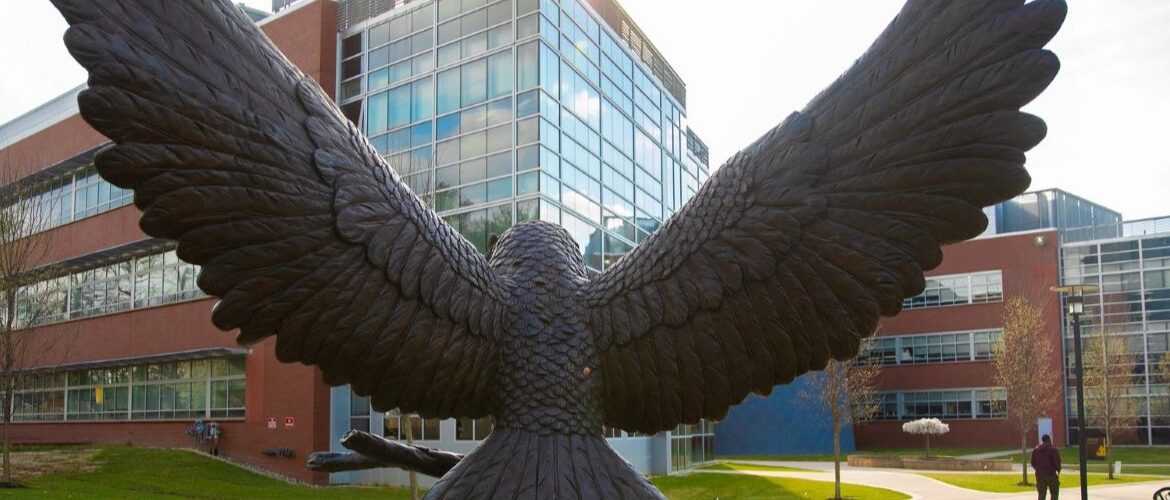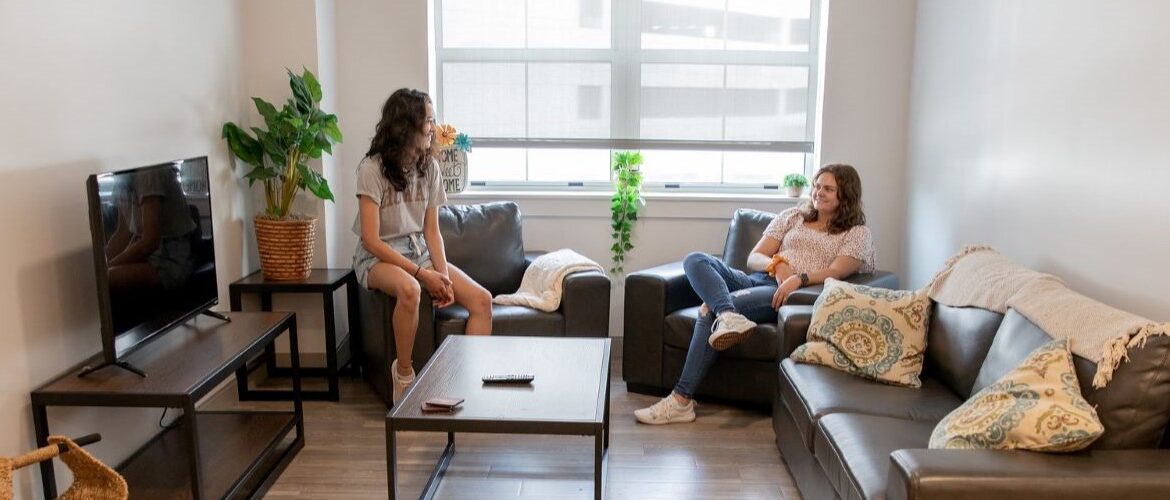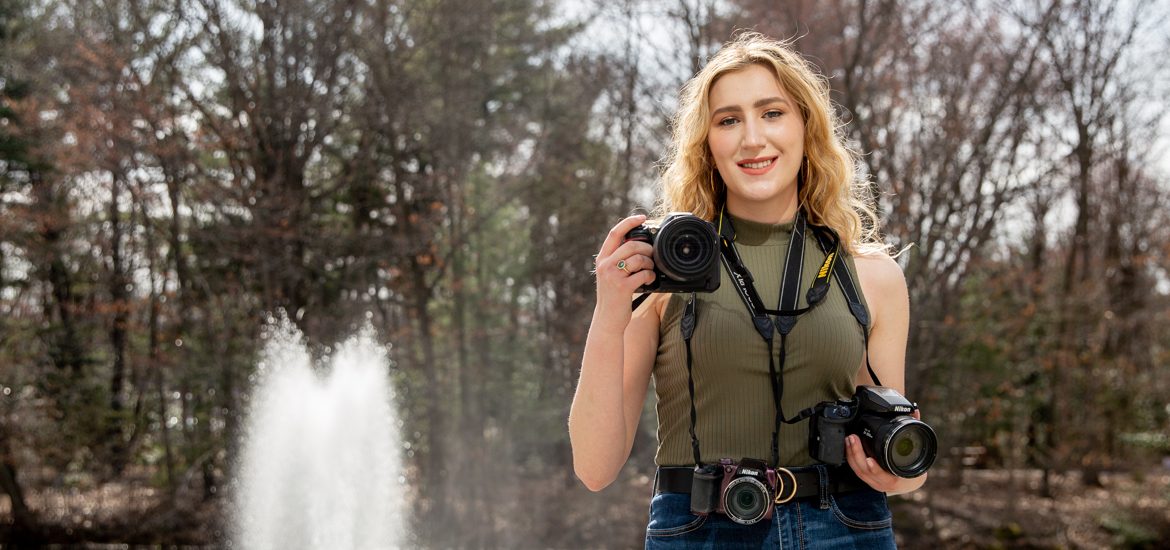Today we spoke to Emerson Harman, a junior Biomedical Art and Visualization major with minors in Biology and Technical and Professional Writing, a concentration in Honors, and a certificate of undergraduate study (CUGS) in Paleo-Art and Visualization. They are an on-campus resident from Dodgeville, Wisconsin. Emerson tells us about their internship, how Rowan helped prepare them for the internship, and where they see themselves in a future career.

Tell me about your internship. What was your day-to-day like?
I interned for the summer at Stantec, an architecture, design, engineering, and environmental science design and consulting firm. The company is based in Canada. The company had 23,000 employees across 23 countries. I was the graphic design intern for the summer, and it was an 8-week program. I worked 40-hour weeks.
I worked on a few different projects both within the Philadelphia office and with interns from across North America. I worked on two projects with two elementary schools in Philadelphia that are getting renovated and added to. One has an existing mural through the MuralArts program of Philadelphia, and I made designs for the new main entrance and cafeteria based on their existing mural. That school is in the very initial design phase and once they get further in with the client, they will present my designs to the client as possible design options for the space. I made designs based on murals that already exist in the other school, as well. On the second to last day of my internship, the people working on this project with me presented my designs to that client, and they actually went forward with my designs, which is pretty exciting.
I did a few smaller graphic projects for different proposals for different projects that people were working on and the intern-wide project. There were 91 interns from across North America on ten teams this summer, and we got paired with an organization in North Carolina that is creating a farmstead summer camp for people with learning disabilities, particularly teens and adults with autism. Five teams worked on each half of the property. As the only graphic design intern, I helped create the presentations and the final booklets that were given to the client and created renderings and animations of the final architectural plans. At the end of the internship, all 10 groups presented our work both internally to the broader Stantec community, and to the client. Throughout this internship, we also had groups and seminars on a variety of topics just for the summer interns, including a counter transition from school to the workplace or innovative technologies and urban planning and climate change adaptation and how they structure sustainability into such a large global company.

Can you tell us a bit about Stantec as a company?
Stantec has many offices that work independently of each other, but sometimes they collaborate. They do architecture, so just like any other architecture firm, they do large and small-scale projects, and then they have design and interior design areas where they work on architectural projects and individual consulting-type projects.
The Philadelphia office where I work didn’t have any environmental scientists, but some offices have environmental scientists that worked with the construction crews or different building projects such as making sure that they’re not getting rid of habitat for endangered species, working near wastewater treatments, or doing anything damaging to the environment. There are many kinds of people working in one company. It’s an all-inclusive firm for these different areas.
How did you find and secure this internship?
I first applied for Stantec’s Equity and Diversity scholarship last year, without really knowing who Stantec was or what they did. I ended up receiving the scholarship, and from there, they invited me to interview for an internship position. Stantec gives about 22 scholarships and from there they select some interns for the summer. During the interview, I met with the Senior Vice President of Design and Innovation of Stantec, the Director of the Office of the CEO, and one of the Principal Architects of the Philadelphia office, who ended up being my supervisor. I received the internship offer, and after school was out, I moved to Philadelphia for the summer.

How does this internship tie in with your major?
My major isn’t directly correlated with the architecture and design industry, but I found that a lot of the skills transferred into this internship as a graphic design intern. I worked a lot in software like Adobe Illustrator, Photoshop, and InDesign, all design software that I use in my classes. Often having to learn new software in my major helped me with learning AutoDesk, Revit, and Enscape that I used a lot during and needed for the internship. Having an outside look at a lot of the design problems my supervisors gave me brought a unique perspective someone trained in architecture might not have.
Do you have any mentors at Rowan that helped you with this internship?
There are a lot of professors and faculty on campus that I definitely have close connections with, but the two that come to mind are initially Professor Amanda Almon, who is the head of the Biomedical Art and Visualization department, and Professor Jenny Drumgoole of the Photography department. I know I can go to them with questions I have. They’re helpful and supportive and help me with applications and just creating a professional profile for myself. When I’m applying for these opportunities, they can help me along the way. Professor Almon, and Professor Drumgoole, having people like them push you to develop your skills and encourage you to apply for internships, and find new opportunities that you might have otherwise missed is important. The most important thing you can do is to connect with those professors. They’re the start of your network, and from there they can help you with so much more.

How will this internship help you achieve your career goals?
I might apply for a master’s program in scientific illustration. Many people in this field wait and do their master’s after some years of experience in the workforce. Ideally, I want to work in infographic design and scientific illustration. I definitely lean more towards the natural science side, rather than the medical side of the biomedical art program, whether that’s working for a museum, a publishing company magazine, like National Geographic or Nature, or something along those lines.
Through this internship, I gained a ton of new connections, met a lot of amazing people, and learned a lot. I went from living in a small town in Wisconsin to living in Philadelphia, which was a very good experience, and significantly different. Now I know I can feel comfortable living anywhere. I also learned new programs and new techniques that I might not have learned if I hadn’t taken the internship. I also learned how to communicate and talk to new people on all levels.

Do you have any advice for Rowan students that are looking for internships?
I would first reach out to professors who work in the areas that interest you and see if they know of any campus or external internships they would recommend applying to. Beyond that, look up companies and organizations in your field and see if they advertise internships on their website. If not, it’s worth emailing them to ask! Make sure you have an up-to-date resumé, and just keep applying. It’s discouraging to be turned down, but the more you apply, the more chances you have of being selected.
Now that you have completed this internship, what’s next?
I just received an offer for a nine-month internship (the duration of the school year) with the U.S. Forest Service. I will create illustrations and graphic design for a visual field guide to endangered species and communications about old-growth forests. It’s through the Virtual Student Federal Service program, so it’s a virtual internship.
Like what you see?
Story by:
Rachel Rumsby, senior communication studies and public relations major














































































































































































































































































































